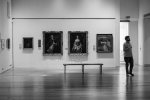Light in a dark world


By Parson Thru
- 1412 reads
I’ll never be blasé about the works in these rooms, but I no longer feel pressured to see everything. It’s like working in a sweet factory long after your hunger for free chocolate has been sated – I’ve done that. There are half a dozen other great museums I can visit within a stone’s throw of this one, but I always come back here. Someone said to me last week that it’s my house, “Es tu casa”. She could have meant home, I suppose, but I like the sound of house best.
I’ve become a fan of video installations lately. I never used to like them, but in the past four weeks I’ve spent hours sitting in front of documentaries, monologues and montages (if that’s the word) – often the only person in the room, sometimes joined by another solitary watcher or two, alighting for a while, then silently flitting. We’re like birds on a telegraph wire.
Occasionally, I sit in one of the airy corridors reading, perhaps with the sun warming my back through the window – a kind of retreat.
I know where all the toilets are. And I know the best ones.
I taught a single one hour class first thing this morning to round-off the week, called for coffee and toast, then walked through the drizzle to get here. I’m not sure whether that was three hours ago or just two and a half.
Third floor today: photographs of housing developments – bubbles that rise promisingly into clear sky, before falling to earth in a kind of embarrassed hiatus. The photos capture communities: kids playing on a broad road that goes nowhere, barred by a rusting fence. A student of mine lived on one of these developments. The scenes he described were just like these – life woven into art.
In the adjoining room I approach a cinema screen from behind. It’s showing three monologues in a single video loop. The theme is development again, and the corruption that mars so many schemes. I watch the end of one film. I watched one last week – or maybe it was the week before. The speaker listlessly lays handwritten notes in front of the camera: one sheet after another, reminding me of Dylan’s “Subterranean Homesick Blues”. She speaks in English.
I go and sit on a bench in the corridor. I’ve brought too many books. I pull out the guide to the collection and read about the 1940s – the years of autocracy and the response of Spanish artists. The story is all around me. I scribble a few notes, attempt a few lines of a poem, then give up and go down to the second floor, home of the estrellas of Spain’s Modern Art.
In the corner of the building overlooking Atocha station, Dali’s transition from Realist, through Cubist, to his own Surrealist form picks up the pace with a painting heavily influenced by the Italian Metaphysical painter, de Chirico. What I hadn’t noticed before was a nearby painting by Palencia in the same style, painted a year after Dali’s, both of them still life. Both men were obviously grappling with the same ideas. A striking example of Palencia’s Cubism hangs at the opposite end of the museum – called “Pueblo”, I think.
A few hours in these places always makes me hungry and light-headed. Time to head home.
Just one last thing: there’s a painting by Robert Delaunay that I just can’t get enough of. I toy with the idea of just grabbing my coat and heading for the bus, but Delaunay draws me.
He and his wife Sonia painted in an avant-garde style that became known as Simultaneism. They rejected traditional techniques of perspective and depiction of depth using light and shade in favour of a vivid contrast of colours painted in energetic swirls – a technique derived from research on light and optics. Sonia’s work “Dubonnet” (1914) is one of the better-known examples. By 1923, when Robert came to produce a portrait of his friend, the poet Tristan Tzara, he was moving back towards orthodoxy, but his selective use of Simultaneist technique in the painting elicits the intimacy of their friendship.
Whenever I talk to anyone about this painting, I always mention the left eye. Tzara’s hands, folded in front of him, seem unfinished. The background and his suit are drab and flat. Only his scarf brings any relief. It’s as if the artist is leading you to the whole point of the sitting. Gazing past the poet’s sensual and articulate mouth, it seems that Delaunay’s main effort was focused on the left eye, painting it with liquid warmth and clarity.
Today, though, as I step back and look, I see for the first time that it’s not the left, but the right eye, rendered in a poetic swirl of contrasting colours, that transmits the lost and faraway nature of Tristan Tzara's soul.
I’m so glad I took the time.
- Log in to post comments
Comments
I envy you, PT. Good writing
I envy you sometimes, PT. Good writing too and you make me want to visit the museum and gaze to my heart's content.
- Log in to post comments
Like all the best writing,
Like all the best writing, makes the reader also hunger for the experience. Sent me off to Google to find out about the Delaunays and to see that particular portrait for myself. Thanks to your thought provoking description, I felt I was looking at more than just a bit of info on the internet. The very essence of teaching.
- Log in to post comments
Evocative, absorbing and
Evocative, absorbing and thoughtful - this is our Facebook and Twitter Pick of the Day! Please share/retweet if you've enjoyed it.
Picture credit: http://tinyurl.com/zfmxy3s
- Log in to post comments


